Intro
If you are looking for a relatively compact phone at a good price, the Google Pixel 8a and the iPhone 15 are two devices that come to mind immediately.
The Pixel 8a is of course much cheaper at $500, while the iPhone 15 retails for $800, but for many people, that might be the choice they are facing.
| Pixel 8a | iPhone 15 |
|---|---|
| Compact size, but slightly thicker | Compact size |
| Similar 6.1-inch screen size, but running at 120Hz | 6.1-inch screen at 60Hz |
| Similar dual camera | Dual rear camera (main + ultrawide) |
| 8GB of RAM | Less memory in the base version (6GB) |
| 128GB or 256GB storage | 128GB, 256GB or 512GB storage |
| Larger battery size (but similar battery life) | Smaller battery size |
| Slow 7.5W wireless charging | Relatively fast 15W MagSafe charging |
| Much cheaper prices, base model costs $500 | Way more expensive, base model sold for $800 |
Table of Contents:
Design and Display Quality
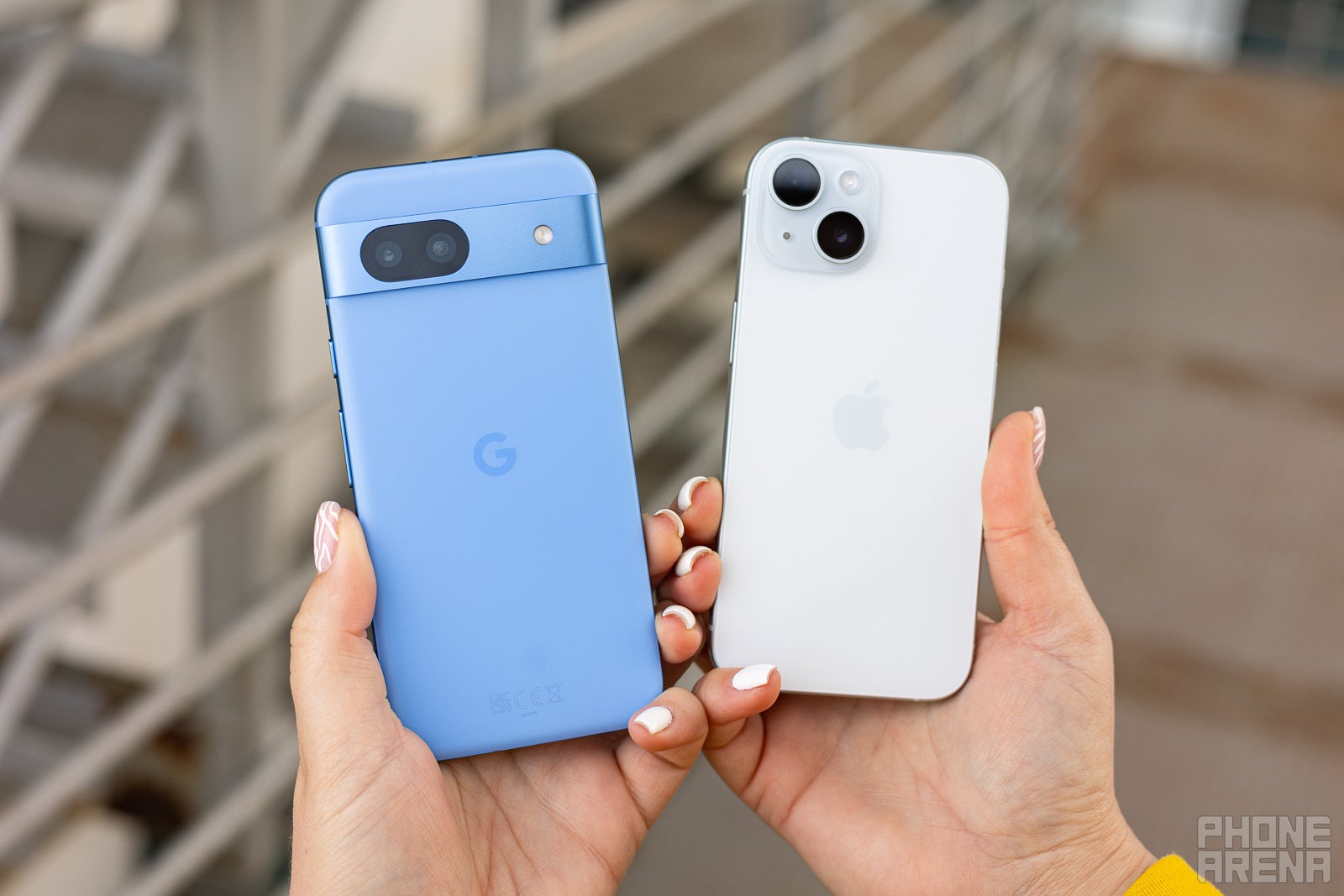

We love the Bay blue color of the Pixel (Image by PhoneArena)
As you can see in the image, it’s easy to tell these two apart: the Pixel definitely has the more fun colors and it comes with the camera bar on the back, while the iPhone is a bit more conservative with its appearance and colors. However, the iPhone weighs less and is not quite as thick as the Pixel, so while both are on the small side, the iPhone feels just a bit more compact.
In terms of materials too, both have an aluminum frame, but the Pixel has a plastic back and the iPhone is made of more premium glass.
Both are dust and water resistant, but the iPhone just a bit more so with an IP68 certification vs IP67 on the Pixel.
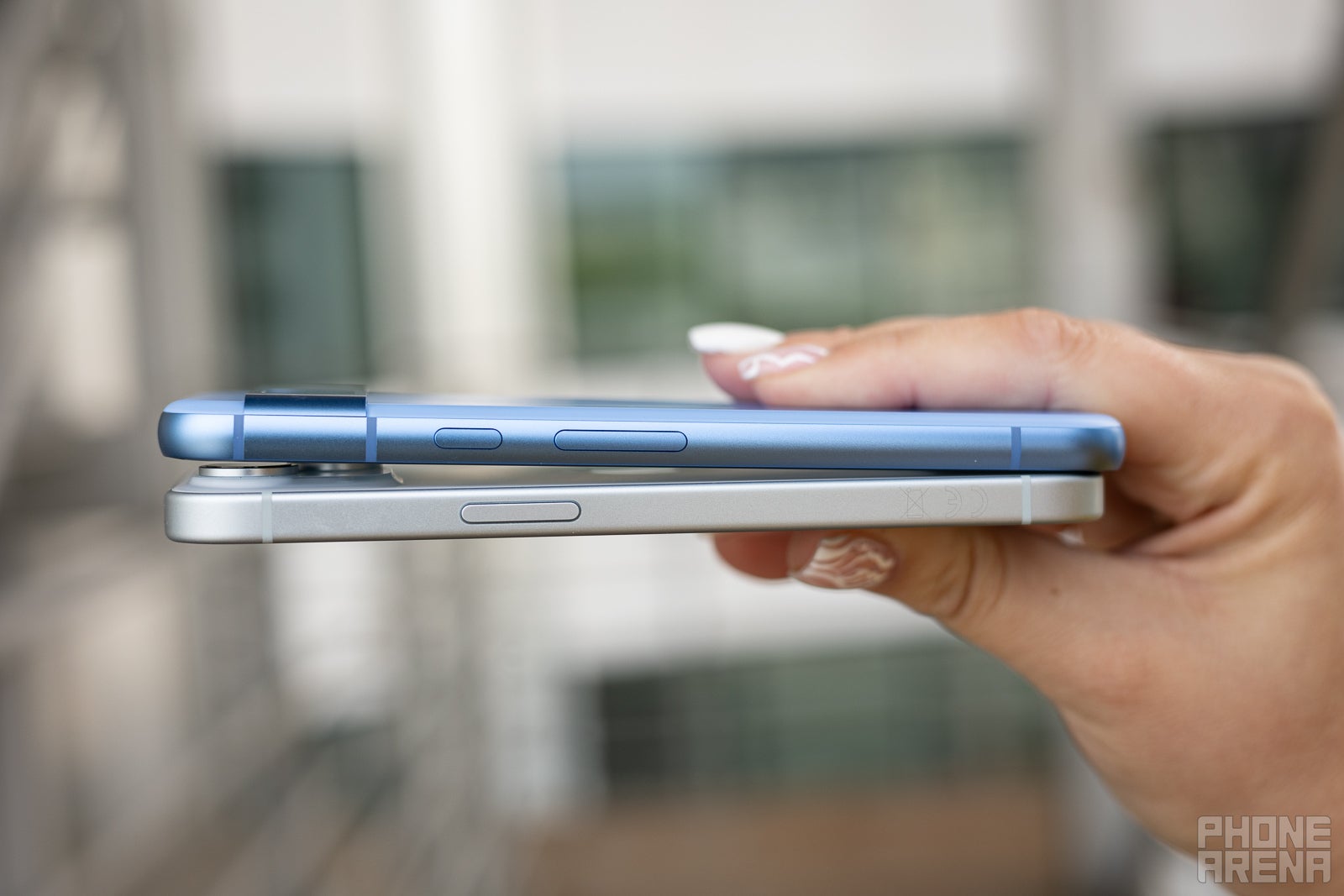

The iPhone has flat sides (Image by PhoneArena)
One other notable design difference is that the Pixel has curved sides, while the iPhone features flat sides. It’s up to you which one you prefer, but the curved sides on the Pixel make it feel better in hand, while the flat sides on the iPhone have the advantage that it’s easier to pick up the phone from a table.
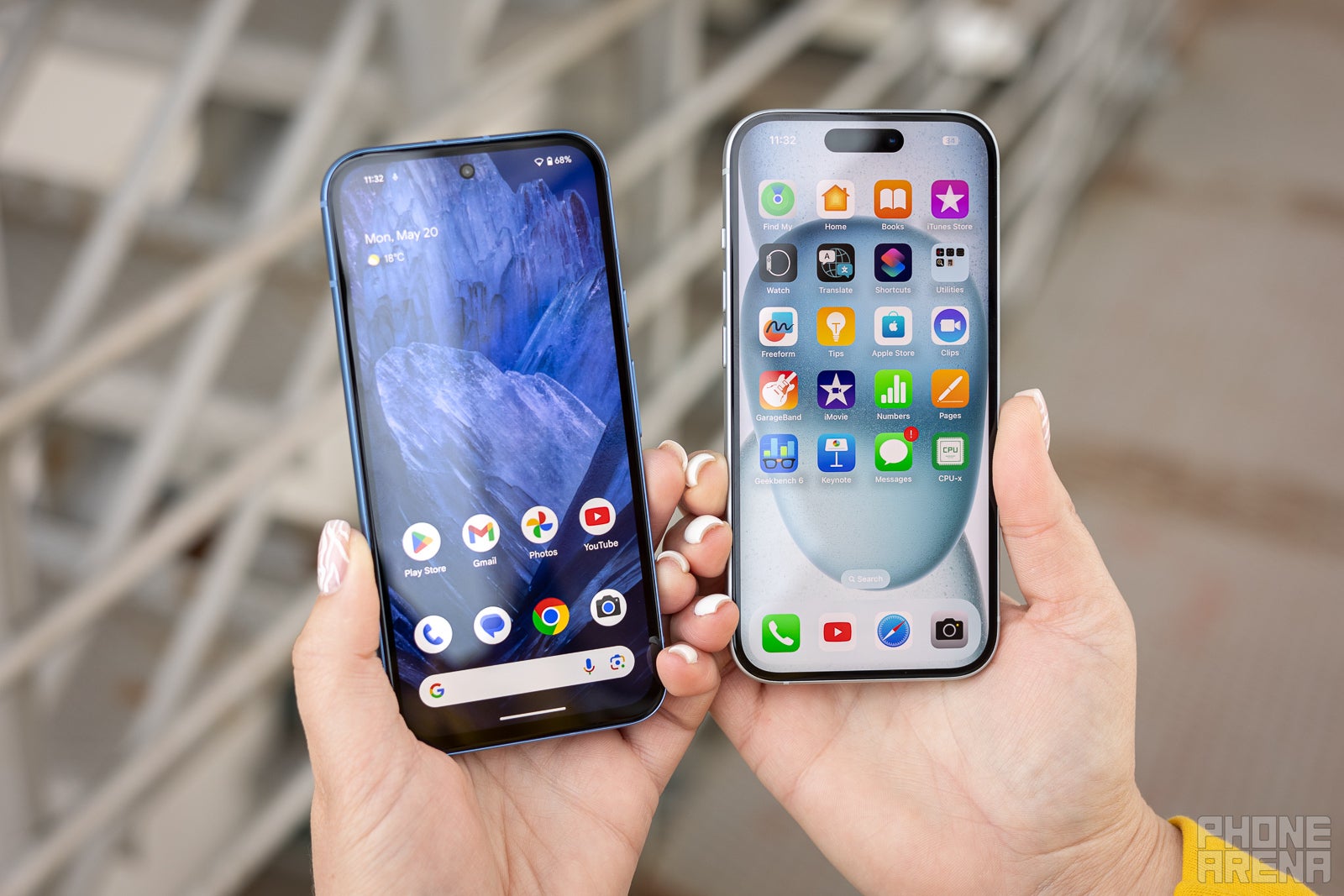

The Pixel has chubby bezels (Image by PhoneArena)
Both phones feature a 6.1-inch screen, but we just cannot unsee the big and ugly bezels on the Pixel 8a. Sure, it’s a cheaper phone and some corners have to be cut, but this really ruins its looks.
However, when you actually use the screen on the Pixel 8a, you immediately notice how much smoother it runs. The Pixel 8a supports 120Hz refresh rate, ensuring buttery smooth swiping, while the iPhone is stuck at 60Hz, and that is quite noticeable indeed as the iPhone feels choppier.
In terms of sharpness, both have a 1080p resolution, which is perfectly fine, so everything looks nice and crisp.
Above, you can see our PhoneArena lab test results, where we measure the screen parameters using professional grade tools. The interesting detail that stands out is the extremely high maximum brightness on the Pixel 8a, which definitely helps with outdoor visibility and it’s a bit easier to use it on a sunny day compared to the iPhone. However, both are still quite reflective.
Performance and Software
Apple has the upper hand
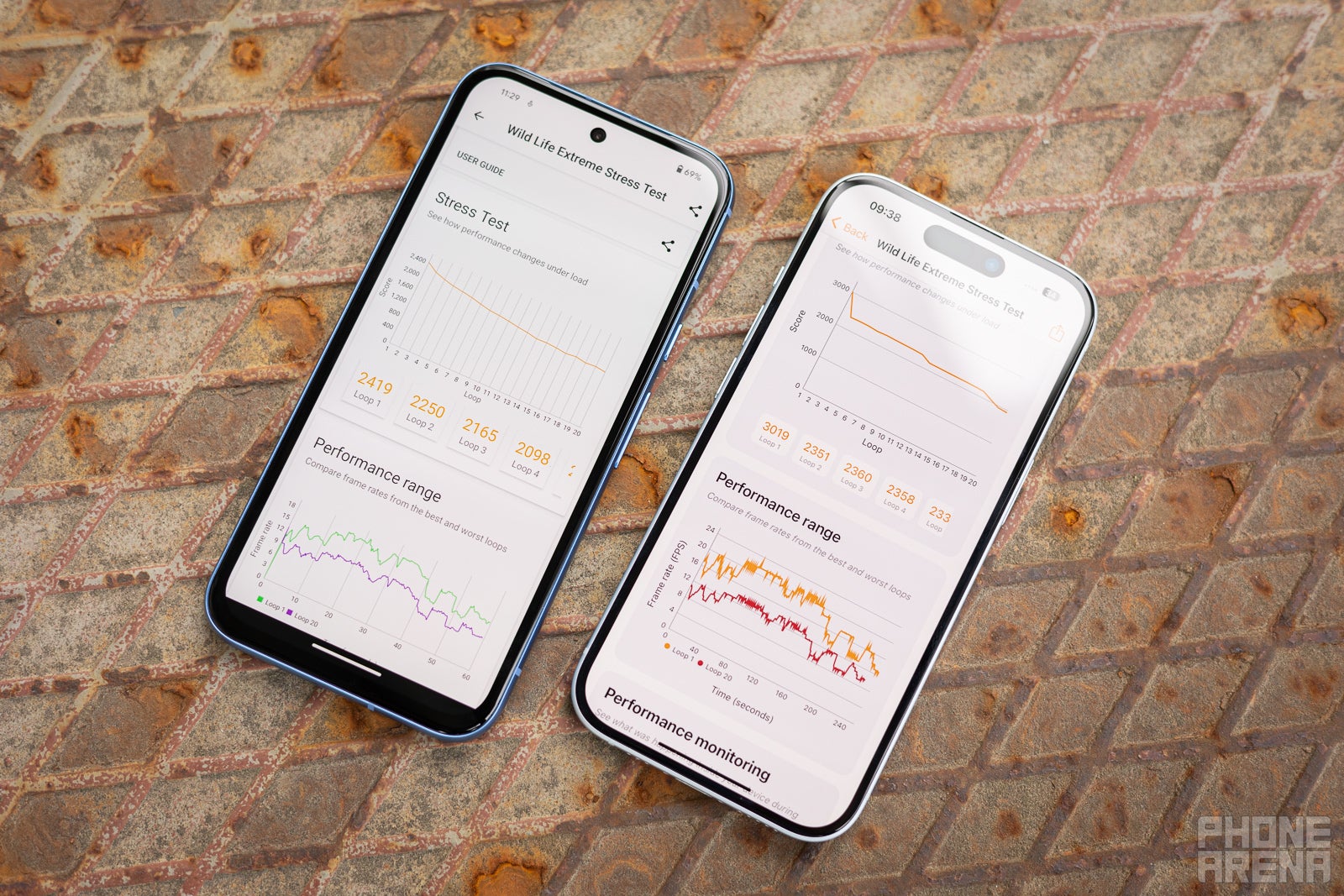

The iPhone clearly packs more punch, but it also throttles faster (Image by PhoneArena)
It is not a surprise that a more expensive phone like the iPhone has more performance power, and it indeed does.
However, in reality, both chips are powerful enough to feel similarly fast.
And despite the faster chipset on the iPhone, it actually often feels less zippy because of that choppy 60Hz refresh rate, while the Pixel 8a often appears smoother despite its slower processor (all thanks to its 120Hz screen).
Performance Benchmarks:
For gaming, however, the advantage of the iPhone should not be underestimated and especially more demanding titles would run at full graphics settings easier on it.
In terms of storage, both models ship with 128GB on the base model, which should be sufficient for most people.
The jump to 256GB storage costs $60 more on the Pixel, and a whopping $100 more on the iPhone (compared to the base models), though, so the Pixel once again offers more value.
Camera
A heated battle
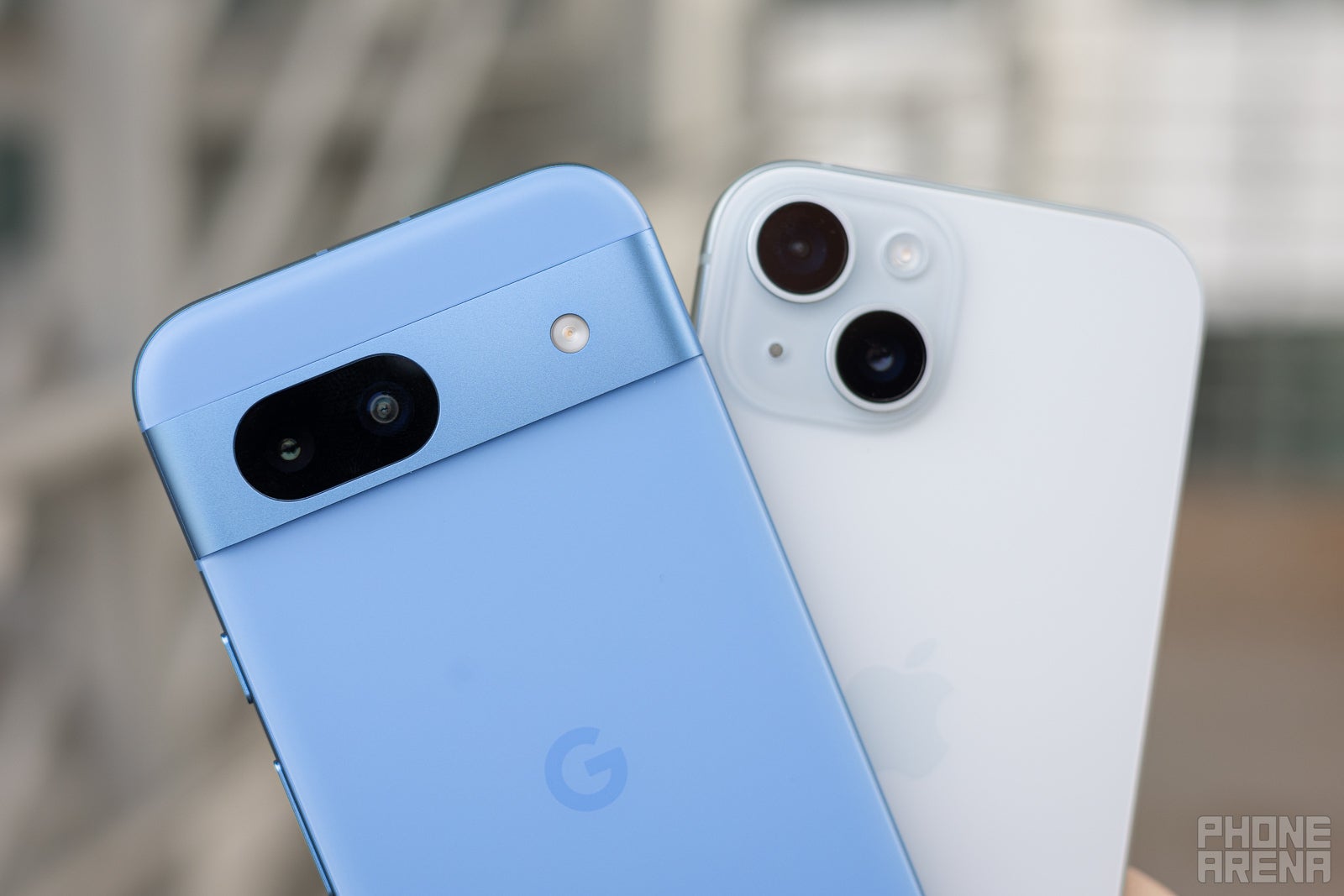

Excellent cameras, but no zoom lens on either one (Image by PhoneArena)
You get two cameras on the back of each of these phones, so unfortunately that means that there is no zoom camera on board.
The main camera that you will be using most of the time is a 48MP one with a 26mm f/1.6 lens on the iPhone and a 64MP one with a 26mm f/1.9 lens on the Pixel. What matters here is sensor size and processing, so you should not read too much into the megapixel numbers. Both phones use quad pixel binning, or in simple terms they combine four pixels into one superpixel, which helps with low light images.
The ultra-wide camera is a 12MP one with a 13mm f/2.2 lens on the iPhone and a 13MP f/2.2 lens on the Pixel. Finally, both have a single front camera, a 12MP one on the iPhone and a 13MP one on the Pixel.
But numbers mean little if the processing is not there, so let’s take a look at some photos, shall we?
Main Camera
Both do an excellent job during the day, but the color science is different.
The iPhone goes for a slightly brighter shot, while the Pixel has a bit darker exposure (both look more or less fine for exposure). The Pixel also has a flatter, more HDR-y look, while the iPhone has a bit more contrast.
The iPhone has a few more tricks up its sleeve though, including a better portrait mode, while the Pixel still struggles for that and it does not even offer a preview of the bokeh when you shoot a portrait.
On the iPhone, you can also shoot at the full 48MP resolution if you want to get that maximum detail, while there is no way to shoot at the full 64MP resolution on the Pixel 8a.
In low light, both capture photos with good clarity and little noise, but the iPhone occasionally errs a bit on the warmer side when it comes to the white balance.
Zoom Quality
No zoom camera on either one, so both use digital zoom, but they actually do a decent job with it.
We’d give the iPhone the upper hand here,
[1 DAY IMAGE FROM EACH PHONE IN SIDE-BY-SIDE GALLERY]
Explain the zoom situation on both, and comment on the differences in the photos.
Ultra-wide Camera
Performance from the ultra-wide camera is quite good on both phones, but with differences in processing.
You notice the better dynamic range out of the Pixel as it preserves better the highlights in the windows (look at the image above).
Selfies
Both phones do a fine job for selfies as well, but the Pixel offers a wider field of view so it’s easier to fit in a larger group of people in the frame.
Video Quality

But when it comes to video quality, the iPhone smokes the Pixel.
The Pixel 8a video still has some weird limitations. For example, specifically in 4K60, once you start recording with the main camera, you cannot switch to the ultra-wide one. The iPhone can do this easily.
And then the quality is also a bit cleaner, a bit more detailed on the iPhone.
Audio Quality and Haptics
Audio quality via the loudspeakers is good on both, but nothing above that.
The iPhone is just a bit more bass-y, but really the difference is not all that huge and for watching videos or playing music, these are a cut above your average smartphone.
We prefer the haptics on the iPhone, though. That Taptic Engine just feels more refined, sharper. The Pixel also does quite well, but it lacks the refinement.
Battery Life and Charging
A slight advantage for the Pixel
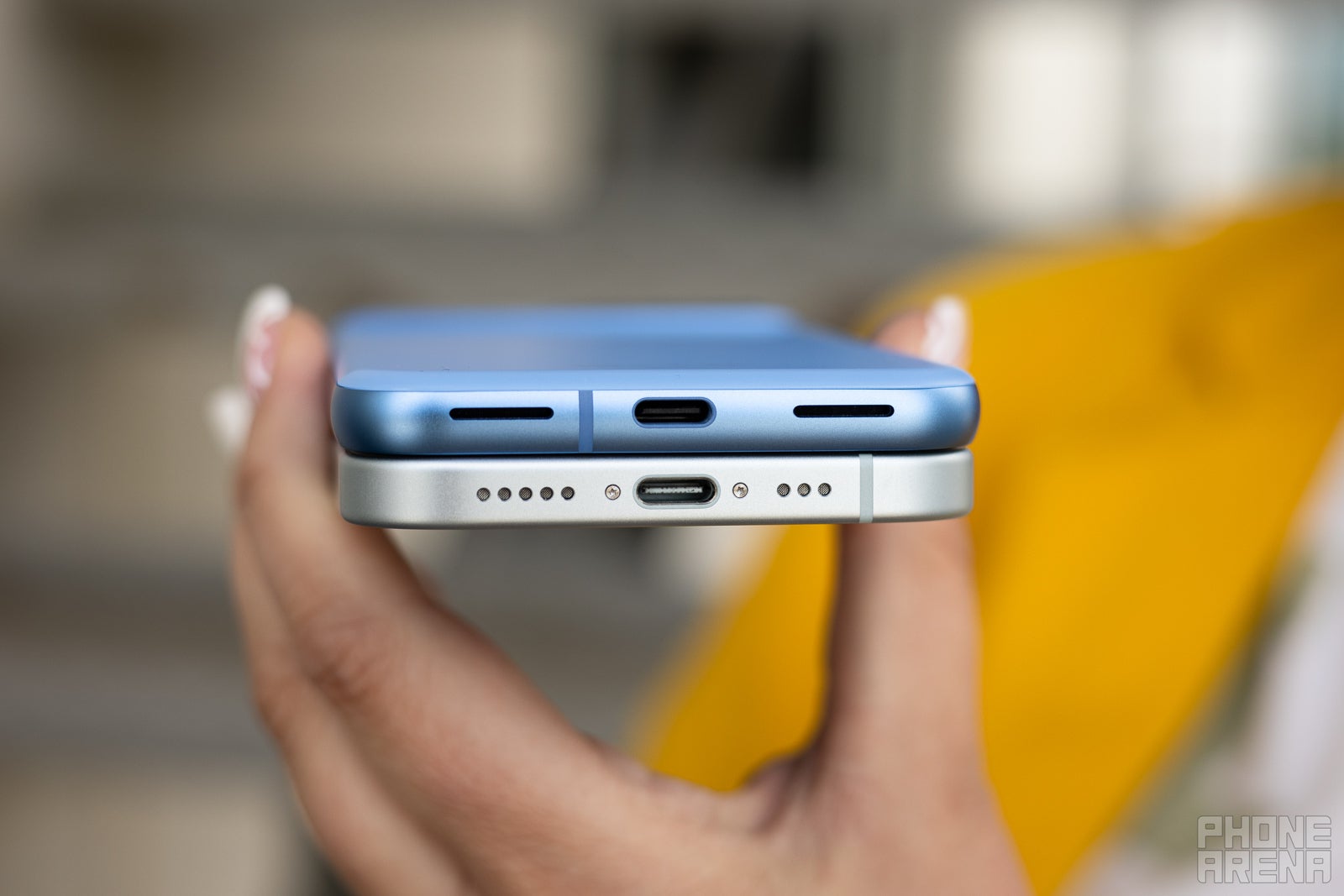

The Pixel has a much bigger battery (Image by PhoneArena)
When you look at the battery size alone, you might think that the Pixel 8a just crushes the iPhone. After all, you get a 4492mAh battery on the Pixel 8a and only a 3349mAh battery on the iPhone, a massive 34% size advantage for the Pixel.
Well, don’t judge so fast because Android and iOS have different battery management, and not in Android’s favor.
Still, we got to test both using our own PhoneArena battery test protocol and here are the results.
PhoneArena Battery Test Results:
As you can see, the Pixel 8a pulls ahead slightly in our lightest web browsing test, and has an even bigger advantage for YouTube video streaming.
The iPhone, however, is a bit more efficient in 3D gaming, but all in all, the Pixel manages to score a win, but it’s not a big one.
PhoneArena Charging Test Results:
We also test charging speeds, and both are… well, kind of slow!
A full charge takes about 1 hour and 50 minutes on both phones, while a 30-minute top-up will replenish 42% on the Pixel and 60% on the iPhone. Here the smaller battery on the iPhone helps.
Both support wireless charging, but the iPhone does it better with MagSafe and 15W speeds compared to no magnets on the Pixel and half the speed at 7.5W. Bring your own wireless charger, of course, there are none provided in the box.
Specs Comparison
| Specs | Pixel 8a | iPhone 15 |
|---|---|---|
| Dimensions | 152.1 x 72.7 x 8.9 mm | 147.6 x 71.6 x 7.8 mm |
| Weight | 188 g | 171 g |
| Screen | 6.1-inch OLED 120Hz | 6.1-inch OLED 60Hz |
| Processor | Google Tensor G3 (4nm) | Apple A16 Bionic (4nm) |
| RAM, Storage and Price | 8/128GB for $500 8/256GB for $560 | 6/128GB for $800 6/256GB for $900 6/512GB for $1,100 |
| Cameras | 64MP main, f/1.9
13MP ultra-wide, f/2.2
13MP front |
48MP main, f/1.6
12MP ultra-wide, f/2.4
12MP front |
| Battery Size | 4492 mAh | 3349 mAh |
| Charging Speeds | 20W wired 7.5W wireless | 20W wired 15W MagSafe wireless |
Which one should you buy?
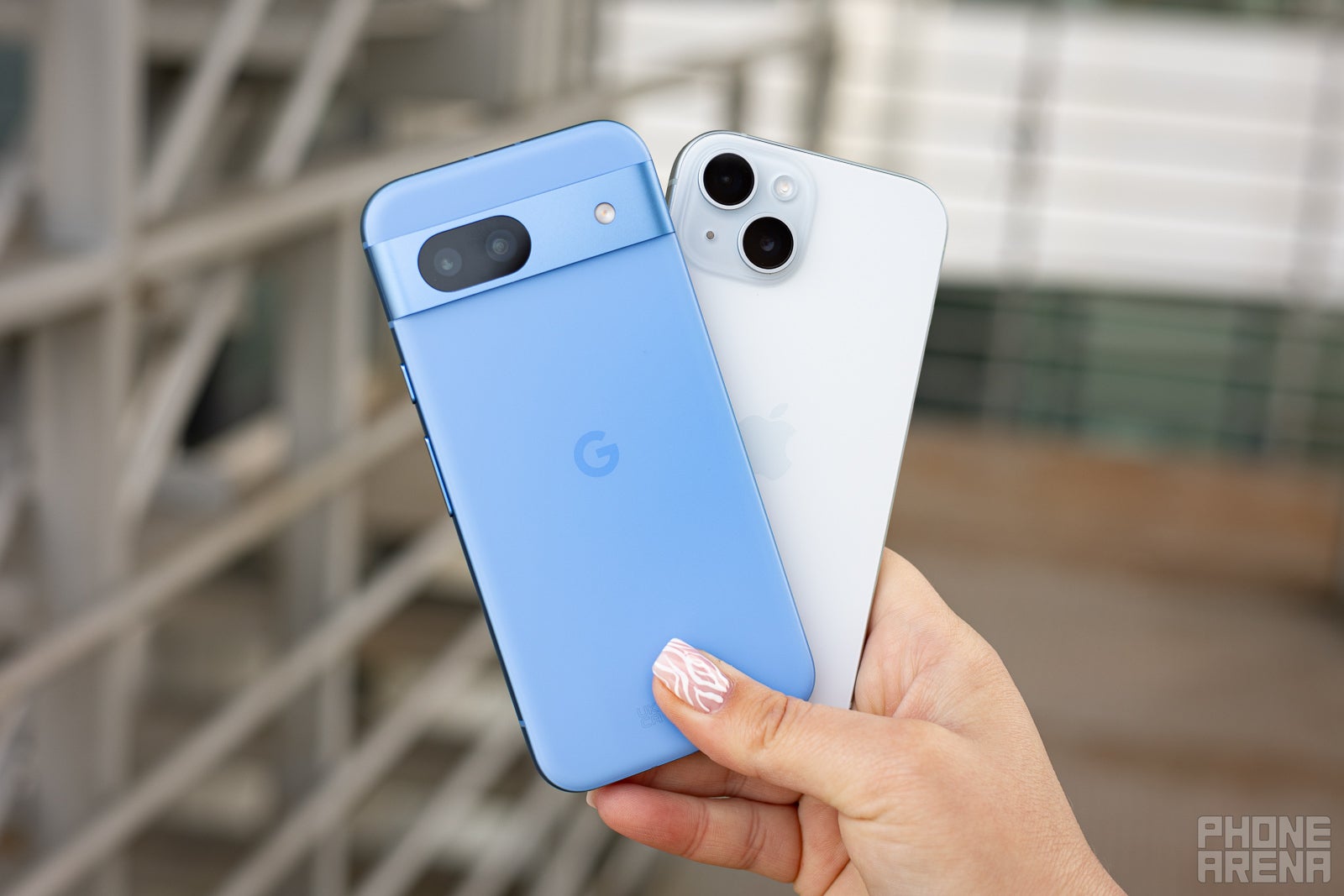

Go for the Pixel if you enjoy Android and don’t mind a slightly uglier phone, go for the iPhone if you want an Apple badge and more firepower (Image by PhoneArena)
Time for the big decision: should you go Team Pixel or is the iPhone a better buy?
Go for the iPhone if you want a slightly more premium phone, with more refined design and faster chipset, and better video recording. Also, go for the iPhone if you value the Apple ecosystem: Apple Watch, Macbook, iPad, AirPods, AirTags and so on, all of them work great together.
So… which one would you go for?
->Google Actualités










